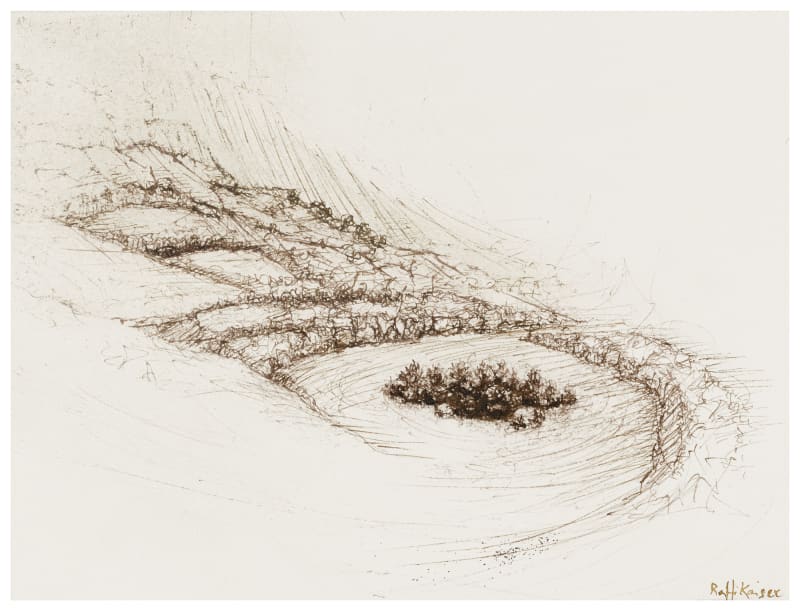Opening: Saturday, February 17th, 11am
In the exhibition we present works by Raffi Kaiser (*1931) from the last two years.
A newspaper article has been published on the occasion of the exhibition.
Link to the article translated into English
RAFFI KAISER – A LATE WORK – REFRESHINGLY YOUNG
At the age of almost 93, Raffi Kaiser has reached the point where we might expect him to produce a late work befitting his old age. He is still active painting and drawing every day as long as he has good daylight in his north-facing Paris studio. He’s no different, in this sense, from his great Japanese role model Sesshu, the painting Zen monk, who may have been born 511 years before him but is no less relevant today. And indeed, their lives have taken not dissimilar paths. Sesshu lived first in Bitchū by the Seto Inland Sea before moving to the capital and art metropolis of Kyoto, where his style developed. Raffi, for his part, studied by the sea in Tel Aviv, then in Tuscany, before moving to the art center of Paris in 1962. Sesshu studied under the greats of his time, namely the likes of Shūbun (1414-63) and Shōkai (there is proof he lived in 1440-1460), while Raffi benefited from the representatives of Fantastic Realism, a style in which he himself was greatly successful. Both were decidedly mature men, when at the age of 47 in both cases, their practice changed fundamentally. Sesshu went on a diplomatic mission to China, to Ningbo and Beijing, where he became acquainted with Chinese painting, while Raffi turned away from painting and its increasingly commercial nature to spend two years in the Negev desert, where he started producing highly intense drawings of the dramatic landscape.
Landscape as a theme had his complete attention once and for all. In 1987, he moved from Paris to China, where he studied the painting of the 14th to 17th centuries and spent months walking through the mountainous regions along the Li River, producing drawings that captured them in their very special light. Back in his studio, his meditative recollection gave rise to the 50-meter-long pencil drawing Large Chinese Landscape (1988-90), a work unlike any other previously created in the history of art. Raffi now became a wandering landscape artist in the tradition of Dürer, Brueghel, and Turner, roaming Japan in the footsteps of the painter-poet Bashō (1644-94) and once again round the Negev. His Large Japanese Landscape (1993-4) and Large Negev Desert (1997-9) illustrate the sensory experiences of these strenuous expeditions in equally monumental format. Smaller excursions followed through the Grand Canyon, where he was also able to spend time living at its base among the indigenous Green People, to the monastic world of Mount Athos, and through southern Africa, and all this flowed into his 66-meter-long drawing Le Voyage des Voyages (2010-1), which summarizes half an artist’s life like the flight of a bird. After a serious illness, he then set out again – this time chauffeured by a friend – on a tour of France, and as a thank-you to his second homeland he created his Large French Landscape (2017-8).
By now, he has seen and created just about everything, one might think. But like Sesshu, who, until the ripe old age of 86, always produced equally lively and exciting paintings as if as a religious exercise, Raffi continues to draw in a way that is forever changing. Hence, his works of the last two years, as presented here at Galerie Friedrich Müller, again show Cascades et Abysses, i.e. waterfalls and chasms. However, they concentrate on the essentials with the even greater focus of sharper lines and harder contours, as can also be seen in the late works of Sesshu. A new format, however, are the three-meter-wide Landscape Meditations, which are drawn with an extremely hard H7 graphite pencil and, only vaguely, with colored pencils. Here viewers’ perception plays tricks on them, as at first you see nothing at all, then something vaguely, and then quite suddenly something incredible. These images represent the true sum of an artist’s long life, having been explored over many months, and are now also to be explored by viewers’ eyes. This is most certainly not strident art, but a form of art that calls for the Zen virtue of nintai as the Japanese describe it: patience, waiting, perseverance. After the boom and commerce of the galleries, Raffi has learned this nintai in the second half of his life with admirable discipline and can now enjoy it in his latter years.
Ulrich Schneider

